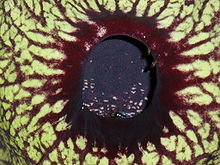Myiophilia


Myiophilia or myophilia refers to the adaptation of flowers to pollination by Diptera ( flies and mosquitoes ) ( Diptera flowers ).
A distinction is mainly made between fly flowers , the carrion fly flowers (Sapromy (i) ophilie) and the mushroom mosquito flowers ( mycetophilia). In a few species, the kleptomy (i) ophilia ( nesting flies , stalk flies ) occurs, here the flowers produce a smell of attacked or trapped (dead) insects in order to attract the kleptoparasite flies.
The fly flowers can also be further subdivided into small and large fly flowers, micro-, macromyiophilia .
The flowers are adapted to pollination by flies and mosquitoes by the following characteristics:
- The flowers are often disc, bowl, kettle trap , sliding, or clamp trap flowers.
- The nectar of the fly flowers is freely accessible, which suits the short trunk of the flies.
- The nectar is missing from the deception flowers (carrion fly and fungus mosquito flowers ).
- The flower color is dirty white, dirty yellow, green-yellow or red-brown, sometimes also flesh-colored, which appeals to the breeding instinct.
- The scent is often aminoid and carrion-like, often nauseating for humans. This scent often occurs together with the red-brown color. Other flowers smell fruity to lemony.
Hoverflies in particular (Syrphidae) can not only suck up the liquid nectar with their proboscis , but also use the teeth on the inside of the lower lip cushion to absorb the pollen . Species that are not mainly pollinated by Diptera species but also by others, such as the common ox tongue ( Anchusa officinalis ) , are not counted among the fly flowers .
Typical fly flowers are many saxifrage TYPES ( Saxifraga ) which Chrysosplenium ( Chrysosplenium ), many euphorbia and clematis ( Clematis ) with white pollen flowers. The swamp heart leaf ( Parnassia palustris ) is a flies deception flower.
The Aristolochiaceae and Rafflesiaceae are predominantly carrion fly and mushroom mosquito flowers. The genus Aristolochia forms kettle trap flowers in which flies are attracted.
To the fungus gnat flowers belonging fungal mimetics , the flowers inside is similar here to the fungal fruit bodies of cap fungus as a lure for pollination. In this way they lure mushroom mosquitoes that want to lay their eggs in the supposed mushroom fruit body. The attraction is probably due to the scent, as the flowers look very little like mushrooms. Fungal mimetics are the tailed hazel root Asarum caudatum from North America and Aristolochia arborea from Mexico, even if the pollinator is unknown.
Alternate leaf spleen ( Chrysosplenium alternifolium )
literature
- Peter Leins: blossom and fruit. Morphology, history of development, phylogeny, function, ecology. E. Schweizerbart'sche Verlagsbuchhandlung, Stuttgart 2000, ISBN 3-510-65194-4 , pp. 219-227.
Individual evidence
- ↑ Theodor CH Cole: Dictionary of Biology. 4th edition, Springer, 2015, ISBN 978-3-642-55327-1 .
- ↑ James D. Blande, Robert Glinwood: Deciphering Chemical Language of Plant Communication. Springer 2016, ISBN 978-3-319-33496-7 , p. 237.
- ^ Joachim W. Kadereit , V. Bittrich: The Families and Genera of Vascular Plants. Vol. XV, Flowering Plants, Springer, 2018, ISBN 978-3-319-93604-8 , p. 221.
- ↑ A. Heiduk, H. Kong, I. Brake, M. von Tschirnhaus et al .: Deceptive Ceropegia dolichophylla fools its kleptoparasitic fly pollinators with exceptional floral scent. In: Front. Ecol. Evol. 3, Art. 66, 2015, doi: 10.3389 / fevo.2015.00066 .
- ↑ Emily Benson: Flower hijacks the fragrance of attacked bees to imprison flies In: New Scientist. October 6, 2016, accessed May 23, 2019.
- ^ O. von Kirchner : Flowers and insects. Teubner, 1911, pp. 193–226, archive.org , Salzwasser, 2012, ISBN 978-3-86444-533-0 (reprint).


